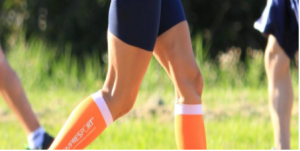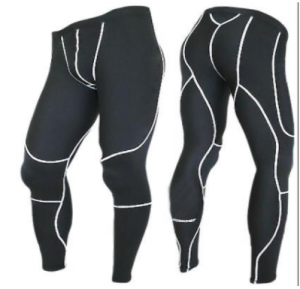By Jake Owen
If you are not yet familiar with compression gear – where have you been living, really? – you need not worry as this is the definitive article on the topic. Compression gear is the extremely tightly fitted clothing often worn by athletes in practice or on game day. Alternatively called pressure garments, it includes t-shirts, tights, socks, sleeves or underwear and it’s often made largely from a spandex type material, a synthetic fiber renowned for its extreme elasticity, or sometimes nylon and latex.
This article thoroughly reviews the current literature on it and sheds light on their many purported benefits.
Often cited benefits of Compression Gear
Until recent years, other than the anecdotal claims of many professional and recreational athletes, there was scarcely any scientific evidence backing up the many supposed benefits of compression gear. Due to their exponential increase in popularity, along with their widespread use, significant progress has been made, with several peer reviewed papers published on the topic.
Claims of reduced delayed onset muscle soreness, improved performance, faster recovery and less fatigue, joint stabilization along with improved oxygenation and circulation on the compressed muscle were – and still are – regularly made but do these claims hold up to scientific scrutiny?
On reducing exercise-induced muscle soreness
A study on the effects of compression garment after heavy resistance training, evaluating eleven men and nine women who were highly resistance trained concluded that there were significant benefits in wearing compression gear. Namely, there were differences in favor of compression garments in post-workout ratings of vitality, resting fatigue, muscle soreness and ultrasound measure swelling amongst others. Conclusively, it seems that the use of compression appears to heavily facilitate the recovery after intense resistance based workouts in both sexes.
Another study, investigating compression garments effects on short-term recover after sprinting and 3-km running performance in rugby union players, much like the previous one, was conclusive in its findings: Relative to placebo, compression socks and garments improved sprint times, lessened fatigue and lowered delayed onset muscle soreness substantially.
A third study, where seventeen female subjects followed a plyometric heavy workout, indicates much the same as the aforementioned ones. Compression clothing seems to be an effective recovery strategy, following exercise-induced muscle damage.
On long distance, endurance exercise
The previous studies investigated instances where the subject’s strength (barbell movements), explosive power (plyometric moves) were heavily taxed, along with heavy-duty speed training in the form of sprinting and high intensity circuit training simulating a rugby game. So far, evidence seems to be conclusively in favor of the compression garments. But is that also the case when it comes to long-distance, endurance running?
According to this study, investigating moderately trained athletes, there was no difference observed between the times to exhaustion performed with or without compression sleeves. A second study, comparing once again compressive and conventional running garments points out that there was no difference in submaximal and maximal oxygen uptake, arterial lactate concentration, oxygen saturation and oxygen partial pressure between the two. Overall, there were no performance benefits when using compression garments.
A third study, however, begins to suggest something different. At higher speeds, lower limb compression gear produced increased regional blood flow and significantly lowered heart rates. Although these findings are certainly interesting, and show that compression gear does result in some cardiorespiratory and psychological benefits, the weight of these improvements appears to be rather small, as they did not correspond in equal improvements in endurance running performance.
Are compression garments right for you?
So far, we’ve presented the results of six separate scientific studies investigating the effects of compression gear on athletic performance. Evidence seems to point towards the following:
- Compression clothing is not a fad. There have been a great number of proven benefits one may experience while wearing them during exercise.
- You are more likely to enjoy the majority of their benefits if you’re doing intense, anaerobic exercise such as weight or plyometric training, or very high speed running like sprinting.
- If you are interested in improving long-distance running performance (and likely similar activities, such as long distance biking) compression garments are unlikely to significantly impact your game positively or negatively.
All in all, as is probably plain to see by now, there is really no reason not to wear compression gear. They have many well documented benefits that will enhance your performance in some areas of fitness and they seem to have zero adverse effects. If you couple their scientifically proven upsides with the widespread anecdotal claims of their positive impact you pretty much have no reason whatsoever not to try them.
Conclusion: The Verdict on Compression Gear
The only thing that is certain is that compression gear does not work like a magic pill. It will definitely not turn you into an elite athlete overnight. But it might well be a relatively inexpensive asset to add to your athletic bag of tricks. It might give you a slight edge when it comes to plyometric, strength training and high intensity running, and it will surely feel comfortable and “just right” when working out.
Therefore, if you’re aiming to get your athletic performance to the next level, compression garments are a thing to consider and in all likelihood, a sound investment. Purposefully, this article neglected to focus on the stylish side of compression gear but this is also one aspect to keep in mind. Nowadays, they come in many designs, shapes and colors and through a little bit of looking around you can definitely find something you fancy to enhance your looks on the field.
On one hand, compression garments are very likely to improve your performance – or at least not adversely affect it. On the other hand, it’s the “in” thing to wear them, whether you are a professional or a recreational athlete, and will improve your looks and style while training. What’s not to like? We would highly recommend you at least give them a try.



